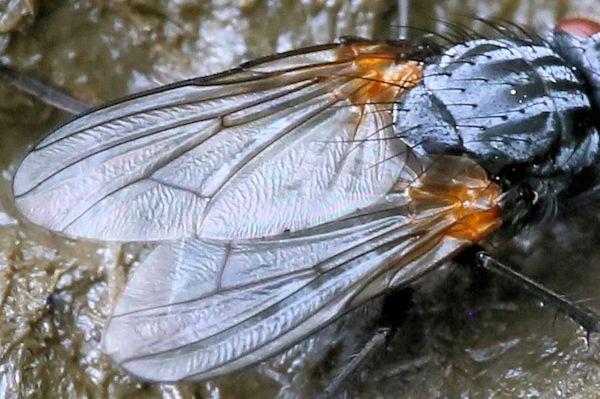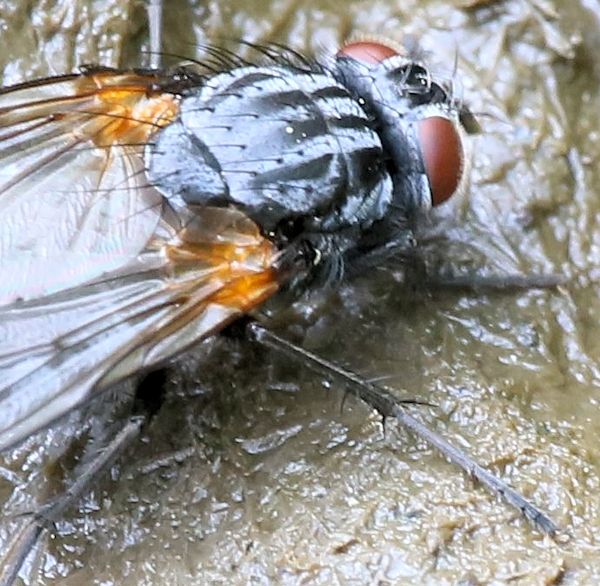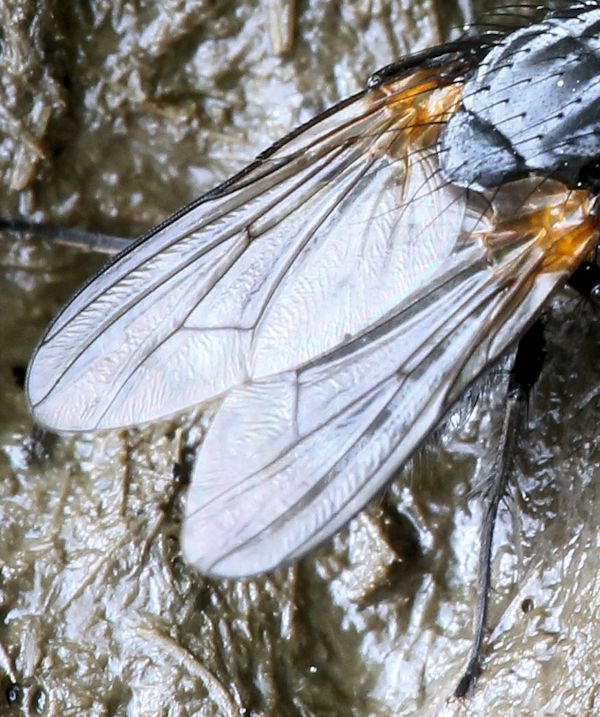Diptera.info :: Identification queries :: Diptera (adults)
|
Is this a Helina species?
|
|
| Gateside |
Posted on 25-06-2018 11:09
|
|
Member Location: Cumbria, UK Posts: 74 Joined: 24.10.13 |
I think this is a type of Muscid, though the venation is unusual. Using the venation as a guide, I believe it to be in the Helina genus. I have used the web site http://www.commanster.eu/commanster/Insects/Flies/wings11d.html but nothing matches perfectly. It is somewhat like Helina lasiophthalma, and Helina trivittata. I see that it has hairy eyes - pale brown and quite long. I have no proper views from the side because of the dung (!) Found in south Cumbria, UK, on cattle dung. Gateside attached the following image:  [91.28Kb] |
|
|
|
| Gateside |
Posted on 25-06-2018 11:10
|
|
Member Location: Cumbria, UK Posts: 74 Joined: 24.10.13 |
A better view of the wings
Gateside attached the following image:  [73.54Kb] |
|
|
|
| Gateside |
Posted on 25-06-2018 11:11
|
|
Member Location: Cumbria, UK Posts: 74 Joined: 24.10.13 |
A better view of the head
Gateside attached the following image:  [101.52Kb] |
|
|
|
| Gateside |
Posted on 25-06-2018 11:12
|
|
Member Location: Cumbria, UK Posts: 74 Joined: 24.10.13 |
A better view of the rear half, especially the hind leg
Gateside attached the following image:  [120.58Kb] |
|
|
|
| tristram |
Posted on 25-06-2018 13:16
|
|
Member Location: Reading, UK Posts: 1333 Joined: 27.06.10 |
The last image appears to show a 'Phaonia bristle' on the hind tibia
Edited by tristram on 25-06-2018 13:20 |
| tristram |
Posted on 25-06-2018 13:21
|
|
Member Location: Reading, UK Posts: 1333 Joined: 27.06.10 |
Maybe a Polietes? |
| Gateside |
Posted on 25-06-2018 15:58
|
|
Member Location: Cumbria, UK Posts: 74 Joined: 24.10.13 |
A good suggestion. I've looked through some Polietes images, and the hind leg is at least consistent (from what I can tell), and the venation spot on for Polietes steinii . I think this looks promising as the right area, rather than my original thought of Helina genus. |
|
|
|
| Tony Irwin |
Posted on 25-06-2018 17:19
|
|
Member Location: Norwich, England Posts: 7327 Joined: 19.11.04 |
Please do not use www.commanster.eu/commanster/Insects/Flies/ at all. It is packed full of misidentifications - I would say there are probably more incorrect than correct names. For instance, Coenosia tigrina appears as four different species of Helina! Avoid the site at all costs, and beware those Wikipedia pages which are illustrated with a commanster photo - they are mostly wrong.
Tony ---------- Tony Irwin |
|
|
|
| Gateside |
Posted on 25-06-2018 21:53
|
|
Member Location: Cumbria, UK Posts: 74 Joined: 24.10.13 |
Noted! That seems pretty clear. I am now well and truly warned. BTW, I used Diptera Info gallery images to check venation on Polietes species. Thanks Tony. Edited by Gateside on 25-06-2018 21:56 |
|
|
|
| johnes81 |
Posted on 27-06-2018 09:36
|
|
Member Location: Berlin, Germany Posts: 1980 Joined: 15.10.16 |
Polietes lardarius is known to breed in dung, so Polietes fits. Phaonia can be eliminated by the presence of a proclinate orbital. I am not sure why the base of the wing is so orange. I have Polietes and my specimens have yellow base at wing but it looks much like a Polietes. John and Nini. Naturalists not experts. |
|
|
|
| Gateside |
Posted on 28-06-2018 08:43
|
|
Member Location: Cumbria, UK Posts: 74 Joined: 24.10.13 |
Thanks for the comments. So it looks to be correct that it is a Polietes species. I decided to use the (old) Muscid key, and there are only 4 species in the UK, which helps a lot! It isn't P.lardarius, and it isn't steini (eyes almost bare, and it goes for horse dung only, but mine is definitely dung from rare cattle), and it isn't albolineatus, which has slightly different venation, and a single broad dust stripe on the thorax. So by elimination alone it is Polietes hirticrus. And it also fits with the key, in having mid tibia with postero-ventral bristles, densely hairy eyes, and a lower squama conspicuously yellow. (I often find that yellow appears more orange in photos - it depends on the degree of illumination). Although I am not an expert, I believe this is correct. It is an unusual species, with only 25 records, and I can find absolutely no images on the web, or on this site. |
|
|
|
| Gateside |
Posted on 28-06-2018 08:52
|
|
Member Location: Cumbria, UK Posts: 74 Joined: 24.10.13 |
I have just found a couple of images for said species Polietes hirticrus, on the iRecord system in the UK. This new recording system has only been going for 10 years at most, and there is a single record, in the Scottish Highlands. It is where most of the UK records are. The 2 images, though of a male, are consistent with my female. I am satisfied my identification is correct. |
|
|
|
| johnes81 |
Posted on 29-06-2018 10:11
|
|
Member Location: Berlin, Germany Posts: 1980 Joined: 15.10.16 |
Hello Gateside, I think that photo comparison is helpful but not accurate. We cannot see the katepisternals or the prosternum. I don't think that the eyes are any more or less hairy than lardarius or meridionalis - which also have posterior bristles on the mid tibia. According to Hennig, hirticrus is similar to lardarius. Personally, i would use a cf in this situation (a few blurry photos and no specimen.) I'm just offering my opinion. I hope that you are not offended. I cannot see enough evidence to bring it to a species level. I'm not an expert or a specialist either but i would prefer the opinion of an expert or specialist, or having genitalia, before dropping a cf. I'm not convinced. You should collect a specimen to be certain of the species. I also do not read anything about a preference for particular cattle dung. Maybe you are correct but i cannot see enough evidence. I hope that you have a pleasant day. John and Nini. Naturalists not experts. |
|
|
|
| Gateside |
Posted on 29-06-2018 13:01
|
|
Member Location: Cumbria, UK Posts: 74 Joined: 24.10.13 |
Hi John and Nini. It is good to be sceptical! I have used the Muscidae key for the UK, by ECM D'Assis Fonseca. Therefore my reasoning is based on this key, which may not be the same as your key. It does not matter that I cannot see the prosternum. The apical section of the discal vein is longer than the previous section, so not P. lardarius. The lower squama is not whitish, either. As a confirming feature, though not in the key, the venation is wrong anyway. Cannot tell if cubital vein is definitely bare or not. Also front tibia not in focus. So have to check each of the 3 remaining possible species. Eyes are not bare and the mid tibia has posteroventral bristles. Therefore not P. steini Eyes densely hairy, and mid tibia with pv bristles. Lower squama conspicuously yellow. P. hirticrus. Finally, it is not P. albolineatus, because although the eyes are densely hairy, there is no conspicuous broad white dusted median stripe. (see images elsewhere to check that feature, and the appearance of the entire fly) I am therefore content that it can only be P. hirticrus Regards Nigel |
|
|
|
| johnes81 |
Posted on 29-06-2018 14:06
|
|
Member Location: Berlin, Germany Posts: 1980 Joined: 15.10.16 |
Hello Gateside, I looked at the keys from Fonseca, then Hennig. I see what you mean now. I apologize for not reading the keys before. The discal vein is longer. I really didn't key it. Again, my apologies. To be honest, i avoid British keys and res books because i find them to be melodramatic and too patriotic (usually contain data only useful to the homeland). For example, if you read British text about Pyrrhocoris apterus, the British text implies that one must find a lime tree in order to find the species. And scientifically, lime is a genus of many species of plants called 'lime' or 'linden'. Here in Berlin, i can find Pyrrhocoris apterus on the sidewalk right now as i type. Not a 'lime' tree in sight. I find them in sandy areas, on pine trees, etc. I stopped using those old res books a long time ago. You also do this: 'but mine is definitely dung from rare cattle'. The cattle is a rare breed and this breed of cattle is the only dung that it can be found upon? or the fly is rare? or the particular species is rarely found on cattle dung? I guess that i cannot understand most British disposition. I try to find alternative text. I really have trouble with res stuff. I am not German either, i just live here. English is my native language but i still don't understand 'but mine is definitely dung from rare cattle'. Anyway, you are right (about the discal vein). I apologize for not making time to key this. I hope that you have a pleasant day. John and Nini. Naturalists not experts. |
|
|
|
| Gateside |
Posted on 29-06-2018 14:46
|
|
Member Location: Cumbria, UK Posts: 74 Joined: 24.10.13 |
Hi John and Nini. I should explain what I meant by saying 'but mine is definitely dung from rare cattle'. I don't think I was being as accurate as I should have been. Here is (hopefully) a batter effort! I was referring to the dung that the female fly had settled on. It is not horse dung (which according to my key, P. sterni lays its eggs on, so I got that wrong). The dung is definitely from a breed of cattle that is rare in the UK, and may not be found elsewhere in Europe. It is called the Albion, and is no longer used, except by people who like to carry on the old ways and traditions before intensive agriculture changed everything. Nigel |
|
|
|
| Jump to Forum: |













